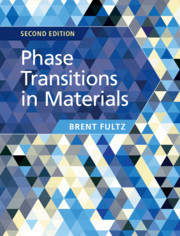Book contents
- Frontmatter
- Contents
- Preface
- Notation
- Part I Basic Thermodynamics and Kinetics of Phase Transformations
- Part II The Atomic Origins of Thermodynamics and Kinetics
- Part III Types of Phase Transformations
- 11 Thermodynamics and Phase Transitions at Surfaces
- 12 Melting
- 13 Solidification
- 14 Phase Transformations with Interfaces: 1. Microstructure
- 15 Phase Transformations with Interfaces: 2. Energetics and Kinetics
- 16 Spinodal Decomposition
- 17 Phase Field Theory
- 18 Method of Concentration Waves and Chemical Ordering
- 19 Diffusionless Transformations
- 20 Thermodynamics of Nanomaterials
- 21 Magnetic and Electronic Phase Transitions
- Further Reading
- References
- Index
15 - Phase Transformations with Interfaces: 2. Energetics and Kinetics
from Part III - Types of Phase Transformations
Published online by Cambridge University Press: 24 April 2020
- Frontmatter
- Contents
- Preface
- Notation
- Part I Basic Thermodynamics and Kinetics of Phase Transformations
- Part II The Atomic Origins of Thermodynamics and Kinetics
- Part III Types of Phase Transformations
- 11 Thermodynamics and Phase Transitions at Surfaces
- 12 Melting
- 13 Solidification
- 14 Phase Transformations with Interfaces: 1. Microstructure
- 15 Phase Transformations with Interfaces: 2. Energetics and Kinetics
- 16 Spinodal Decomposition
- 17 Phase Field Theory
- 18 Method of Concentration Waves and Chemical Ordering
- 19 Diffusionless Transformations
- 20 Thermodynamics of Nanomaterials
- 21 Magnetic and Electronic Phase Transitions
- Further Reading
- References
- Index
Summary
Chapter 15 develops further the concepts underlying precipitation phase transformations that were started in Chapter 14. Atoms move across an interface as one of the phases grows at the expense of the other. The interface, an essential feature of having two adjacent phases, has an atomic structure and chemical composition that are set by local thermodynamic equilibrium, but interface velocity constrains this equilibrium. Interactions of solute atoms with the interface can slow the interface velocity by "solute drag." When an interface moves at a high velocity, chemical equilibration by solute atoms does not occur in the short time when the interface passes by. These issues also pertain to rapid solidification, and extend the ideas of Chapter 13. Solid–solid phase transformations also require consideration of elastic energy and how it evolves during the phase transformation. The balance between surface energy, elastic energy, and chemical free energy is altered as a precipitate grows larger, so the optimal shape of the precipitate changes as it grows. The chapter ends with some discussion of the elastic energy of interstitial solid solutions and metal hydrides.
Keywords
- Type
- Chapter
- Information
- Phase Transitions in Materials , pp. 398 - 423Publisher: Cambridge University PressPrint publication year: 2020



